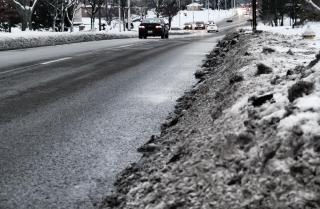Snow Pollution

When we imagine a snowstorm, we think of a landscaped coated in white and fluffy snow. Now, it’s a few days later. The snow is grey, black, and no longer a beautiful, serene picture of a winter’s day. As the days go on, the snow becomes less and less picturesque. But why?
Surface pollution from our everyday activities, accumulates in the snow and snowbanks. These pollutants are slowly released through salt-induced melts and warmer temperatures, where they travel to the nearest storm drain. This runoff is filled with salt, sand, combustion byproducts, animal waste, hydrocarbons, and metals, all while flowing, untreated, into our waterways. The amount of runoff which makes it to a storm drain also poses a threat. The more water which ends up in our creek system, the higher its water levels will reach. Even in winter we can experience flooding events from snow melt. How can we better manage our snow care to lessen the amount of surface pollution?
- Salt in high concentrations is harmful to wildlife and plants. Use less to keep these chemicals out of natural systems! Even if you don’t see a salt crystal, it doesn’t mean that the ice isn’t melting down. The salt has combined with the slush and water and will continue to melt away at the ice. If you use too much, clean up the excess or consider using sand or regular kitty litter as a less toxic alternative. If you wish to avoid a chemical application all together, chipping ice off pavement is another option. If you decide on this method, be sure to prevent damages to paved surfaces.
- Pile up your snow in pervious areas. When the snow melts while on a pervious area, it will be able to infiltrate directly into the ground. By reducing the amount of runoff down our storm drains, it will reduce the amount of water in our stream systems and prevents high leveled streams and creeks. This also prevents surface pollutants from making their way into a storm drain.
- Before an impending snowstorm, check your downspouts for obstructions or debris accumulated within them so the water on your roof has somewhere to collect. Otherwise, the snowmelt will runoff your roof and collect along your home’s foundation.
